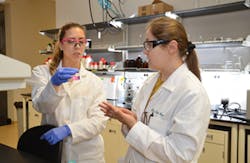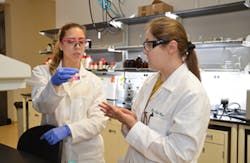For years scientists have been aware of the potential problems of antibiotics being present in wastewater, and new research is now showing that treatments to clean wastewater may actually be creating new antibiotics and further contributing to the development of antibiotic resistance in the environment.
An assistant professor of Civil and Environmental Engineering at UNC Charlotte, Olya Keen, Ph.D., began her current research into the behavior of antibiotics in wastewater in the summer of 2014. She recently presented her initial findings at a conference of the American Chemical Society held in Denver, Colorado.
This research is a small piece of a larger question,” Dr. Keen said. “There are varieties of antibiotics found in wastewater, and at this point we are just testing one. It is in a class of antibiotics that all have similar compositions, so we anticipate that other antibiotics in this class may respond the same way.”
The antibiotic Dr. Keen and her student are studying is doxycycline, which fall into one of the more widely used classes of antibiotics. Their research to date is showing that chlorine used to treat wastewater is actually changing the makeup of the doxycycline and forming new antibiotics.
“Wastewater treatment is designed to break down biological substances, but not antibiotics,” Keen said. “Surprisingly enough, though, we are finding in the lab that not only is chlorine not breaking down antibiotics, but it is actually creating even stronger antibiotics than the original doxycycline.”
READ ALSO: Wastewater Reuse Gains Steam In California as Drought Conditions Persist
Antibiotics find their way into wastewater in several ways. Antibiotics not broken down by the human body are passed to wastewater, expired antibiotics from homes and hospitals are dumped into wastewater, and there is discharge of antibiotic materials from pharmaceutical companies.
“Wastewater tests have found every type of antibiotic known,” Dr. Keen said. “The problems antibiotics cause when they are not broken down by treatment is they get into streams, where bacteria are becoming immune to them, and more dangerous, super bug, bacteria can be formed.”
Keen’s lab is currently working with controlled samples, treating doxycycline with chlorine. Using a mass spectrometer, they separate samples by the mass of the molecules to identify their makeup. The next step in their research will be to treat and test real-world wastewater samples.
Nicole Kennedy-Neth, a doctoral student in the Infrastructure and Environmental Systems Ph.D. program, is performing the laboratory experiments. “Antibiotics in wastewater are already impacting aquatic life,” she said. “This can lead to the development of antibiotic-resistant bacteria, which humans and animals may not be able to fight off. We’re hoping to eventually find better ways of breaking down the antibiotics during wastewater treatment, or developing preventative solutions to keep antibiotics out of wastewater in the first place.”
Source: UNC Charlotte



